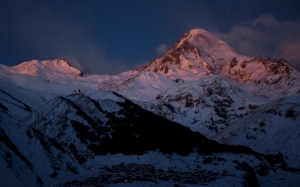Building the Resilience of Mountain Communities in the Face of Crisis
Spectacular mountains occupy 65% of Georgia’s territory, providing the country with priceless resources of clean energy and water and ideal locations for farming, recreation and tourism. But highland residents face high rates of poverty and high risks from the devastating weather extremes that come with climate change. This year, International Mountain Day stresses the importance of highlands as a bountiful yet delicate shelter for both humans and nature.
Working closely with the Government, communities and development partners, including Switzerland and Austria, UNDP is helping to address the economic, environmental and social challenges faced by Georgia’s highlands and create policies and programmes aiming at preserving and developing these unique regions.
“Starting with majestic Kazbegi, mountains are the defining visual image for Georgia,” said UNDP Head Louisa Vinton. “The people who live in Georgia’s highlands are hardy and resilient by nature. But they need support to protect their livelihoods and their natural surroundings. UNDP is working to ensure that this distinctive feature of Georgian culture can survive and thrive.”
“Highland development is a priority for the Government of Georgia, building on successful examples from our partner countries,” said Deputy Minister of Regional Development and Infrastructure Mzia Giorgobiani. “We pay particular attention to ensuring access to services, economic activities and decision-making for people living in mountainous municipalities. Mountains are the natural, cultural, economic and social heritage of Georgia. They must be cherished and protected.”
Economic challenges and environmental hazards are some of the reasons behind depopulation and exodus of youth from the highlands - half of all settlements of Georgia are located in high mountain areas but only 9.7 percent of the country’s 3.7 million people live there. To counter the deprivation and boost economic growth, UNDP runs a robust USD 5.5 million regional and local development programme supported by Switzerland and Austria, with a special focus on mountainous regions.
“Switzerland, as a mountainous country itself, is very well aware of the challenges that highlanders face. This is the reason why we are eager to share our experience and support economic initiatives driven by the local communities,” said Dr. Danielle Meuwly, Regional Director of the Swiss Cooperation Office for the South Caucasus.“Local people know best what is needed for mountainous regions and have thus to be part of the decision-making process.”
“Systemic assistance to vulnerable and marginalized communities such as those living in the highlands, is at the heart of Austria’s assistance to Georgia”, said Alexander Karner, Head of the Austrian Development Cooperation (ADC)’s local office in Tbilisi. “A substantial part of our support is dedicated to community and municipal initiatives, including sustainable mountain tourism and organic agriculture. We firmly believe that lasting development can only be achieved with the active engagement of citizens.”
Georgia adopted a Law on the Development of High Mountainous Regions in 2015, paving the way for systemic policy efforts to address highland challenges. In 2019, with assistance from UNDP, the Swiss Agency for Development and Cooperation (SDC) and ADC, the Government endorsed the country’s first four-year Strategy on the Development of High Mountainous Settlements, committing new funding of USD 240 million for the period of 2019-2020 to promote economic development, improve social welfare and expand access to people who live in Georgia’s highest mountain regions.
Since 2016, nearly 1,800 settlements in Georgia have received high mountain status and many have benefitted from UNDP projects that aim to support local entrepreneurship, renewable energy, waste management and environmental tourism.
With support from Switzerland and Austria, UNDP provides funding for community and municipal initiatives focused on local economic development. So far, seven highland municipalities were awarded a total of USD 195,000, with over 65,000 highlanders benefiting from the projects. In addition, community and civil society organisations in nine mountainous municipalities received USD 266,000 for local development initiatives, benefitting over 4,000 highland residents.












